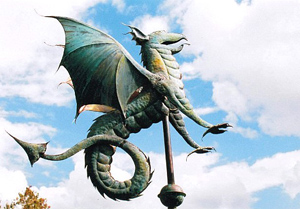Unique Copper Weathervanes Crafted from Old World Metalsmithing
 David Smith, Weathervane Sculpture.
David Smith, Weathervane Sculpture.The confinement of his nine-to-five proofreading job inspired David Smith to try his hand at artistic endeavors.
“In 2001, a series of coincidences led me to copper,” he recalls. “I was researching verdigris--how and why copper oxidizes to its characteristically beautiful shades of turquoise--when I came across a photo of an antique rooster weathervane. Though a generic design, the rooster piqued my interest. To my amazement, I discovered that weathervane sculpture was a long lost art with only a handful of full-time artists. I considered elevating it to a new level, beyond the realm of craft and tradition.”
Smith soon began experimenting, and soon discovered he was a natural.
“I had no art experience or training whatsoever so spent many nights in my shop, working until dawn,” he says. “I hammered and experimented with exotic patinas. I began with simple sheet copper relief sculptures, using the ancient technique of repousse. It had a perfectly natural and familiar feel to it, as if it were something I had done before.”
Completely self-taught, Smith continued exploring new ways to work with metal.
“After mastering repousse, the next logical step was learning to use a torch and solder,” he says. This seemed almost insurmountable at times, until I finally got past the difficulty. I then embarked on my first weathervane, but encountered several perplexing problems and almost gave up. Determined to complete the piece, I was forced to try some innovative techniques of my own. That encouraged me to create another weathervane, which a friend suggested I sell."
Smith received a good price for it, and soon was flooded with commission requests. He then found himself booked with several months of work.
“Fourteen years later, I am still making weathervanes,” he says. “My inspiration comes from nature as well as classical art, especially from the Baroque era. My sheet copper is 99.9% pure, manufactured by Revere Copper Company - America's oldest corporation - founded by Paul Revere and still owned by his family. Making copper weathervanes is like alchemy. There is a division of the work into practical effort and visionary reward.”
Smith has numerous reasons for his copper preference. He mentions its history, antimicrobial properties, classification as an element and usage in everything from wiring to pipes. He loves its wonderful malleability, natural range of warm colors and how it lends itself to nature studies. He notes it has a melting temperature of approximately 2000F and that hammering will harden it and annealing (heating) will return it to its original softness. He likes that it is 100% recyclable without any loss of quality.
Smith's work is all hand forged. He uses no molds, stamps or machines. The average piece takes 80 to 450 hours, depending on the size and complexity. His only tools consist of 8- and 16-ounce ball peen hammers, duckbill shears for cutting the sheet copper, a propane torch, silver alloy solder and an occasional found object for texture. In his designs he often adheres to the form follows function principle associated with modern architecture and industrial design in the 20th century. The principle is that the shape of an architectural element should be primarily based upon its intended function or purpose.
Many of his weathervane designs are mythical subjects: griffins, gargoyles, basilisks, even a minotaur.“Envy, War, Pestilence,” a serpentine dragon weathervane, was commissioned by Discovery Channel Productions in Burbank and appeared on their popular Monster House series. Former Heinz Ketchup CFO Paul Renne bought two weathervanes for his historic Victorian home in downtown Pittsburgh. Michael F. Ryan, Esq., an attorney in Cortlandt Manor, NY, has collected Smith's work for years and owns ten of his original weathervanes. Smith created others for PBS's Antiques Roadshow producer Robert Marshall in Boston, Larry Levinson Productions in Los Angeles, and a copper lightning rod/weathervane for the Tesla Science Center and Museum at Wardenclyffe. His work has appeared in the Wall Street Journal, the Houston Chronicle, and a feature story on the popular long-running television show Texas Country Reporter. He is one of a handful of artists designated a "Texas Original" by the Texas Commission on the Arts.
“My weathervanes are punishing the wind in 45 states, as well as seven foreign countries. My current project is an esoteric series of 'Petromutants,' hypothetical creatures that thrive in oil-rich environments. It's my spoof of the infamous BP oil spill, an artistic indictment of the fossil fuel industry and a satirical look at the future of the environment.”
David's weathervanes have also been chosen as a Featured Project in CDA's Architecture section.
Resources:
Also in this Issue:
- Carolina Bronze: Sculptural Puzzle Solving
- Patina Studio: Enhancing the Natural Beauty of Copper through Science
- Teaching the Touch of Copper and Brass
- Unique Copper Weathervanes Crafted from Old World Metalsmithing
- BMA Acquires Monumental Magritte Bronze
